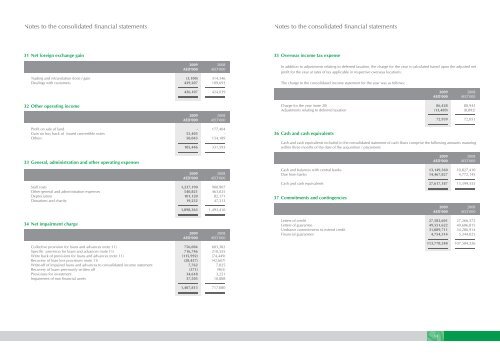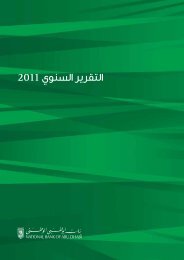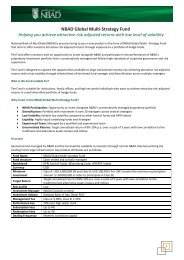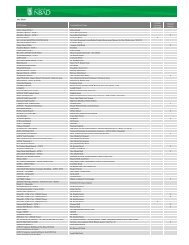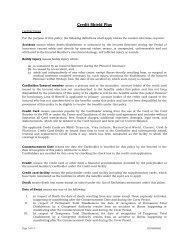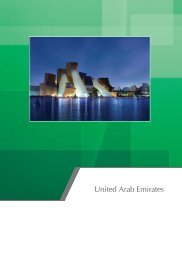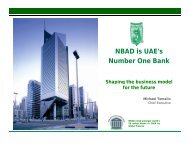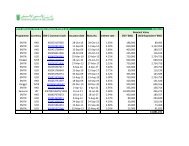English Version - National Bank of Abu Dhabi
English Version - National Bank of Abu Dhabi
English Version - National Bank of Abu Dhabi
You also want an ePaper? Increase the reach of your titles
YUMPU automatically turns print PDFs into web optimized ePapers that Google loves.
Notes to the consolidated financial statements<br />
Notes to the consolidated financial statements<br />
2 Basis <strong>of</strong> preparation (continued) 3 Significant accounting policies (continued)<br />
(i)<br />
Determination and presentation <strong>of</strong> operating segments<br />
As <strong>of</strong> 1 January 2009 the Group determines and presents<br />
operating segments based on the information that is<br />
internally provided to the Chief Executive, who is the<br />
Group’s chief operating decision maker. This change<br />
in accounting policy is due to the adoption <strong>of</strong> IFRS 8<br />
Operating Segments. Previously operating segments<br />
were determined and presented in accordance with IAS<br />
14 Segment Reporting. The new accounting policy in<br />
respect <strong>of</strong> segment operating disclosures is presented as<br />
follows.<br />
An operating segment is a component <strong>of</strong> the Group<br />
that engages in business activities from which it may<br />
earn revenues and incur expenses, including revenues<br />
and expenses that relate to transactions with any <strong>of</strong> the<br />
Group’s other components. An operating segment’s<br />
operating results are reviewed regularly by the Chief<br />
Executive to make decisions about resources to be<br />
allocated to the segment and assess its performance, and<br />
for which discrete financial information is available.<br />
Segment results that are reported to the Chief Executive<br />
include items directly attributable to a segment as well<br />
as those that can be allocated on a reasonable basis.<br />
Head <strong>of</strong>fice segment is comprised <strong>of</strong> head <strong>of</strong>fice as well<br />
as aggregated individually insignificant segments.<br />
(ii) Presentation <strong>of</strong> financial statements<br />
The Group applies revised IAS 1 Presentation <strong>of</strong><br />
Financial Statements (2007), which became effective as<br />
<strong>of</strong> 1 January 2009. As a result, the Group presents in the<br />
consolidated statement <strong>of</strong> changes in equity all owner<br />
changes in equity, whereas all non-owner changes in<br />
equity are presented in the consolidated statement <strong>of</strong><br />
comprehensive income. Comparative information has<br />
been re-presented so that it also is in conformity with the<br />
revised standard. Since the change in accounting policy<br />
only impacts presentation aspects, there is no impact on<br />
earnings per share.<br />
(iii) Amendments to IFRS 7<br />
The amendments which became effective as <strong>of</strong> 1 January<br />
2009 require disclosures <strong>of</strong> financial instruments<br />
measured at fair value to be based on a three-level fair<br />
value hierarchy that reflects the significance <strong>of</strong> the inputs<br />
in such fair value measurements. The amendments<br />
also require additional qualitative and quantitative<br />
disclosures <strong>of</strong> liquidity risk.<br />
3 Significant accounting policies<br />
The accounting policies set out below have been<br />
applied consistently to all periods presented in these<br />
consolidated financial statements and have been applied<br />
consistently by Group entities.<br />
(a) Basis <strong>of</strong> consolidation<br />
(i)<br />
Subsidiaries<br />
Subsidiaries are entities controlled by the Group.<br />
Control exists when the Group has the power to govern<br />
the financial and operating policies <strong>of</strong> an entity so as to<br />
obtain benefits from its activities. The financial statements<br />
<strong>of</strong> subsidiaries are included in the consolidated financial<br />
statements from the date that control commences until<br />
the date that control ceases.<br />
The consolidated financial statements <strong>of</strong> the Group<br />
comprise the <strong>Bank</strong> and its fully owned subsidiaries as<br />
listed below:<br />
Country <strong>of</strong> incorporation<br />
<strong>Abu</strong> <strong>Dhabi</strong> International <strong>Bank</strong> Inc.<br />
Curacao, Netherlands Antilles<br />
<strong>Abu</strong> <strong>Dhabi</strong> Financial Services LLC<br />
<strong>Abu</strong> <strong>Dhabi</strong>, Services LLC, United Arab Emirates<br />
<strong>Abu</strong> <strong>Dhabi</strong> <strong>National</strong> Leasing LLC<br />
<strong>Abu</strong> <strong>Dhabi</strong>, United Arab Emirates<br />
NBAD Trust Company (Jersey) Limited<br />
Jersey, Channel Islands<br />
NBAD Private <strong>Bank</strong> (Suisse) SA<br />
Geneva, Switzerland<br />
<strong>Abu</strong> <strong>Dhabi</strong> <strong>National</strong> Islamic Finance Company<br />
<strong>Abu</strong> <strong>Dhabi</strong>, United Arab Emirates<br />
Ample China Holding Limited Hong Kong, China<br />
(ii) Special purpose entities<br />
Special purpose entities are entities that are created to<br />
accomplish a narrow and well defined objective. The<br />
financial statements <strong>of</strong> special purpose entities are not<br />
included in the Group’s consolidated financial statements<br />
except when the substance <strong>of</strong> the relationship is that the<br />
Group controls the special purpose entity. Information<br />
about the Group’s special purpose entities is set out in<br />
note 43.<br />
(iii) Fund management<br />
The Group manages and administers assets held in<br />
trust or in fiduciary capacity on behalf <strong>of</strong> investors. The<br />
financial statements <strong>of</strong> these funds are not included in<br />
these consolidated financial statements. Information<br />
about the Group’s fund management and fiduciary<br />
activity is set out in note 42.<br />
(iv) Transactions eliminated on consolidation<br />
The carrying amount <strong>of</strong> the <strong>Bank</strong>’s investment in each<br />
subsidiary and the equity <strong>of</strong> each subsidiary is eliminated<br />
on consolidation. All significant intra-group balances,<br />
and unrealised income and expenses arising from intragroup<br />
transactions are eliminated on consolidation.<br />
(b) Financial assets and liabilities<br />
(i)<br />
Recognition<br />
The Group initially recognises loans and advances,<br />
customers’ deposits, medium term and subordinated<br />
debt on the date that they are originated. All other<br />
financial assets and liabilities are initially recognised<br />
on the statement <strong>of</strong> financial position when, the Group<br />
becomes a party to the contractual provisions <strong>of</strong> the<br />
instrument.<br />
All regular way purchases and sales <strong>of</strong> financial assets<br />
are recognised on the settlement date, i.e. the date the<br />
asset is delivered to or received from the counterparty.<br />
Regular way purchases or sales <strong>of</strong> financial assets are<br />
those that require delivery <strong>of</strong> assets within the time<br />
frame generally established by regulation or convention<br />
in the market place.<br />
(ii) Derecognition<br />
The Group derecognises a financial asset when the<br />
contractual rights to the cash flows from the financial<br />
asset expire, or when it transfers the rights to receive<br />
the contractual cash flows on the financial asset in a<br />
transaction in which substantially all the risks and rewards<br />
<strong>of</strong> ownership <strong>of</strong> the financial asset are transferred.<br />
The Group derecognises a financial liability when its<br />
contractual obligations are discharged or cancelled or<br />
expire.<br />
The Group enters into transactions whereby it transfers<br />
assets recognised on its statement <strong>of</strong> financial position,<br />
but retains either all or substantially all <strong>of</strong> the risks and<br />
rewards <strong>of</strong> the transferred assets or a portion <strong>of</strong> them.<br />
In such transactions, the transferred assets are not<br />
derecognised from the statement <strong>of</strong> financial position.<br />
Transfers <strong>of</strong> assets with retention <strong>of</strong> all or substantially<br />
all risks and rewards include repurchase transactions<br />
(note 16).<br />
The Group also derecognises certain assets when it<br />
writes <strong>of</strong>f balances pertaining to the assets deemed to be<br />
uncollectible (note 4).<br />
(iii) Designation at fair value through pr<strong>of</strong>it or loss<br />
The Group has designated financial assets and liabilities<br />
at fair value through pr<strong>of</strong>it or loss when either:<br />
• the assets or liabilities are managed, evaluated and<br />
reported internally on a fair value basis; or<br />
• the designation eliminates or significantly reduces an<br />
accounting mismatch which would otherwise arise.<br />
(iv) Held for trading<br />
Trading assets are those assets that the group acquires<br />
for the purpose <strong>of</strong> selling in the near term, or holds as<br />
part <strong>of</strong> a portfolio that is managed together for short-term<br />
pr<strong>of</strong>it taking.<br />
Trading assets are initially recognised and subsequently<br />
measured at fair value in the statement <strong>of</strong> financial<br />
position with transaction costs taken directly to the<br />
consolidated income statement. All changes in fair<br />
value are recognised as part <strong>of</strong> net trading income in the<br />
consolidated income statement. Trading assets are not<br />
reclassified subsequent to their initial recognition.<br />
(v) Designation as available for sale and held-to maturity<br />
The Group has non-derivative financial assets designated<br />
as available for sale when these are not classified as<br />
loans and receivables, held-to-maturity investments or<br />
financial assets at fair value through pr<strong>of</strong>it or loss.<br />
Held-to-maturity investments are non-derivative assets<br />
with fixed or determinable payments and fixed maturity<br />
that the Group has the positive intent and ability to hold<br />
to maturity, and which are not designated as at fair value<br />
through pr<strong>of</strong>it or loss or as available for sale.<br />
47


